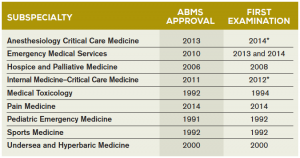★ SEPTEMBER 1: The AMA increased the number of AMA PRA Category 1 Credits from 25 to 60 credits for successfully attaining board certification by passing the oral examination or successfully maintaining certification by passing the ConCert Examination. Diplomates are given up to six years from the effective date on their certificate to apply for the credits.
Explore This Issue
ACEP Now: Vol 33 – No 10 – October 2014, ACEP Now: Vol 37 – No 06 – June 2018★ SEPTEMBER 28: The ABMS, at its General Assembly meeting, approved EMS as its 112th subspecialty, making it the sixth subspecialty available to ABEM diplomates.
2011
★ FEBRUARY: An EMS Examination Task Force, composed of 12 EMS physicians, was appointed by ABEM. The first examination was administered in the fall of 2013.
★ ABEM introduced the next phase of EMCC by changing the requirements and frequency of the EMCC activities required to continue certification.
★ APRIL 1: CME for completing the 2011 LLSA CME activity became available. This opportunity was the result of an unprecedented collaboration between ABEM, ACEP, and the American Academy of Emergency Medicine (AAEM). Diplomates can apply for credit for this activity through either AAEM or ACEP. CME is available with the 2011, 2012, 2013, and 2014 EM LLSAs, the Patient Safety LLSA, the 2013 Medical Toxicology LLSA, and the 2014 EMS LLSA. ABEM did not raise fees during 2013–2014.
★ SEPTEMBER 21: The subspecialty of Internal Medicine-Critical Care Medicine (IM-CCM) was unanimously approved. Emergency physicians can now participate in IM–sponsored CCM fellowships and are eligible to seek board certification. IM-CCM became the seventh subspecialty certification available to ABEM diplomates.
2012
★ JUNE: ABEM was approved by the Centers for Medicare and Medicaid Services (CMS) to participate in the Physician Quality Reporting System (PQRS) MOC incentive program. An additional 0.5 percent reimbursement on Medicare billings is available for meeting their basic PQRS reporting requirements. ABEM was approved again in 2013 and 2014. More than 4,100 ABEM diplomates applied for the 2013 bonus, receiving an estimated $2.3 million for participating. EM participated in the PQRS MOC to a greater extent than any other specialty.
★ SEPTEMBER: The Emergency Medicine Milestones were approved. The EM Milestones are a matrix of the knowledge, skills, abilities, attitudes, and experiences that should be acquired at different points during EM training. The EM Milestones Project was a joint initiative of the Accreditation Council for Graduate Medical Education (ACGME) and ABEM, and was supported by representatives of the Association of Academic Chairs of Emergency Medicine (AACEM), AAEM, ACEP, Council of Emergency Medicine Residency Directors, EMRA, RRC-EM, and SAEM.
2013
★ The ConCert examination was no longer the final step in renewing certification, delinking the four parts of MOC. Diplomates can, therefore, register for and take the ConCert examination in any of the last five years of certification, even if they have not completed all of their MOC requirements. However, at the end of a diplomate’s ten-year certification, any outstanding MOC requirements will result in loss of certification.
Pages: 1 2 3 4 5 | Single Page





One Response to “History of the American Board of Emergency Medicine: Timeline of Progress”
July 1, 2018
Robert RothsteinDo you have permission to publish the Mail gram from Dr Podgorny?